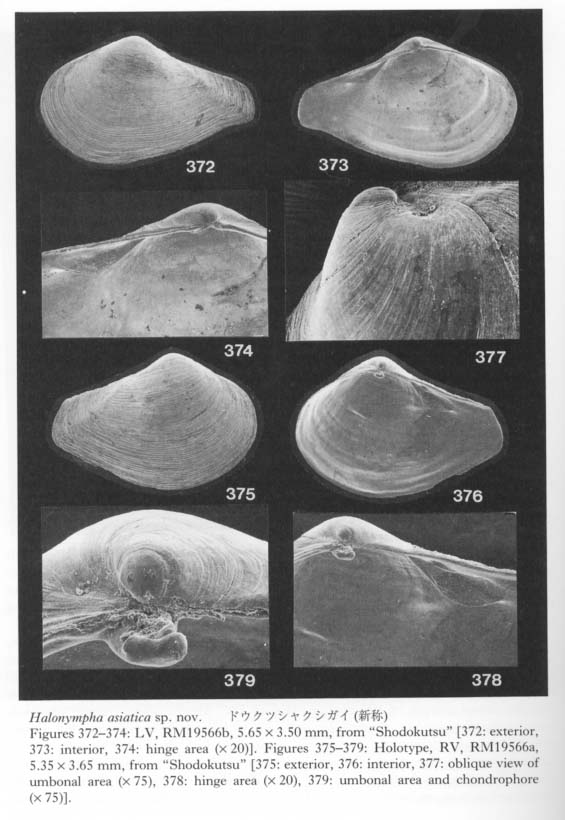Halonympha asiatica sp. nov.
Figures 372-379

1992. Halonympha sp., Kase and Hayami, Jour. Moll. Studies, vol.58, p.448, listed.
1993. Halonympha sp., Hayami and Kase, Univ. Mus. Univ. Tokyo, News, no.27, p.3, fig.9.
Type and material.—Holotype: RM19566a, a left valve, from the bottom sediments of "Shodokutsu" of Ie Islet, Okinawa. Paratypes: RM19566 from the type locality. No living specimen has been found.
Diagnosis.— Small-sized cuspidariid, characterized by slightly inequivalve shell with broader posterior rostrum in RV, blunt posterior carina, fine commarginal lamellae, a tubercular subumbonal tooth in RV, an obliquely triangular chondrophore in LV, and a well-developed internal buttress below middle portion of postero-dorsal margin in each valve.
Description.— Shell small for cuspidariids, rarely exceeding 6.0 mm in length, slightly inequivalve, whitish and opaque, moderately inflated, 1.4-1.5 times longer than high. Umbo slightly prosogyrous, located a little anteriorly from mid-length. Posterior rostrum relatively short, somewhat broader in RV than in LV, suggesting that the dorsal margin of RV overlaps that of LV. Antero-dorsal margin rounded; postero-dorsal margin nearly straight, obliquely truncated by posterior margin. Poste- rior area bluntly delimited by a carina. Surface smooth except for densely spaced commarginal lamellae. A tubercular subumbonal tooth developed below umbo in RV, while LV is almost edentulous. An obliquely elongated triangular chondrophore observed below post-umbonal margin of LV. Posterior internal buttress (shelf-like process for the attachment of posterior adductor muscle) low-triangular, considerably broad, roundly concave, situated below middle course of postero-dorsal margin in each valve. Pd I subovate, considerably large, ranging 161-184 µm in maximum diameter; Pd II not discriminated.
Remarks.— The well-developed posterior internal buttress suggests that this cuspidariid belongs to Halonympha, which has been known mainly from bathyal abyssal waters of the Atlantic. It resembles Neaera claviculata Dall, 1881, the type species of Halonympha, but differs from the Caribbean species in the smaller size, broader posterior rostrum and more anteriorly located umbo. It may be closer to Neaera congenita Smith, 1885, from the sea off Bermuda, but the posterior internal buttress seems to be broader in the present species. Neaera depressa Jeffreys, 1881, from the northern Atlantic, which was anatomically studied and assigned to Halonympha by Alien and Morgan (1981), reveals a similar outline but differs from the present species in the presence of a large chondrophore not only in LV but also in RV and a more rectangularly trigonal posterior internal buttress. Cuspidaria salamensis Jaeckel and Thiele in Thiele and Jaeckel (1931) from the bathyal substrata off Dar es Salaam has a similar posterior buttress, but the posterior rostrated part is much reduced, and the chondrophore of RV is probably undeveloped in the African species.
Although all the specimens are disarticulated, the broader posterior rostrum of RV suggests that the dorsal margin of RV overlaps that of LV, as described by Okutani and Ito (1983) in Cuspidaria sadoensis from the bathyal bottom off Sado Island, the Japan Sea. The present species is similar to that cuspidariid in shell-size and shape, but a tubercular tooth of RV and internal buttress are undeveloped in C. sadoensis.
Cuspidariidae as well as the Poromyidae are generally regarded as carnivorous bivalves, which feed largely on minute bottom-dwelling crustaceans (Reid and Reid, 1974; Morton, 1981; Allen, 1983). The present cuspidariid is a solitary septibranch bivalve in the cavernicolous fauna. It is unknown whether this species is still alive or already extinct, but numerous empty valves are contained in the bottom sediments of the innermost part of the cave "Shodokutsu". Minute interstitial (?) amphipods are found alive on the sediment surface in these caves, and such diminutive crustaceans possibly provide nutrition for the carnivorous bivalve to feed on.
Distribution.— Empty shells occur abundantly in a sublittoral cave of Ie Islet, Ryukyu Islands. This species has not been found in any cave of Shimoji and Irabu Islets.